Assessing Visual Preferences of the Local Public for Environmental Mitigation Measures of Hydropower Impacts—Does Point-of-View Location Make a Difference?
Abstract
1. Introduction
- (1)
- Establish a standardized procedure for preference assessments using visualization of mitigation measure scenarios;
- (2)
- Shed more light on the issue of aerial versus on-the-ground perspectives in terms of potential improvement of visual assessment studies. For the latter objective we tested the hypothesis that there are no significant differences between public visual preferences for scenarios with an on-the-ground perspective and scenarios with an aerial perspective.
2. Materials and Methods
2.1. Study Area
2.2. Method Outline
2.3. Selection of Sites and Environmental Measures for Scenario Development
- (1)
- A pre-study assessment report by Sweco [36] that proposed a series of potential structural mitigation measures at the weirs in the Nea River.
- (2)
- Expert opinion discussions by an interdisciplinary project group of research scientists active in the HydroCen national research center, including hydraulic engineers, fish ecologists, and a social scientist. This group of experts inspected the weirs in the Nea River during a joint visit in June 2019, discussed the measures proposed by Sweco in 2015, and drafted an adjusted set of measures coherent with new insights and experiences from research and practice, e.g., Pulg et al. [12].
- (3)
- Flow conditions: We used the minimum summer flow of 1.5 m3/s as a basis in the upstream part of the study area. In addition, we added a flow scenario of 3.0 m3/s as a realistic requirement after an upcoming revision of concession terms [37]. The flows were used as an input for the hydraulic assessment.
- (4)
- A qualitative pre-study of recreational use in the area as reported in [3], where the addition of recreational infrastructure on the riverbank near the weirs as a potential mitigation measure related to local visual preferences was identified.
2.4. Hydraulic Modeling of Environmental Measure Scenarios
2.5. Creating Water-Covered Area Outline Maps
2.6. Visualization of Environmental Measure Scenarios
2.6.1. Taking Baseline Photographs
2.6.2. Visualizing Water-Covered Area, Changes in Weirs, and Recreational Infrastructure
2.7. Setting Up the Questionnaire and Conducting the Survey
2.8. Characteristics of the Survey Respondents
3. Results
3.1. Water-Covered Area Outlines from Hydraulic Model
3.2. Visual Scenarios
3.3. Visual Preferences for On-the-Ground versus Aerial Scenarios
4. Discussion
4.1. A standardized Procedure for Visualization of Mitigation Measures
4.2. On-the-Ground versus Aerial View
4.3. Weir Adjustment and Modeling
5. Conclusions
Author Contributions
Funding
Informed Consent Statement
Data Availability Statement
Acknowledgments
Conflicts of Interest
References
- Abazaj, J.; Moen, Ø.; Ruud, A. Striking the Balance between Renewable Energy Generation and Water Status Protection: Hydropower in the context of the European Renewable Energy Directive and Water Framework Directive. Environ. Policy Gov. 2016, 26, 409–421. [Google Scholar] [CrossRef]
- Forseth, T.; Harby, A. Handbook for Environmental Design in Regulated Salmon Rivers. 2014. NINA Special Report 53. 90 pp. Available online: www.nina.no/archive/nina/PppBasePdf/temahefte/052.pdf (accessed on 6 October 2021).
- Skår, M.; Köhler, B. Rekreasjonsinteresser i Utvidet Miljødesign: Demovassdrag Nea. 2019. HydroCen report No. 9. Available online: www.ntnu.no/documents/1269211504/1279317385/Rapport_Nea_Nr9.pdf/62254e43-fc23-460e-aac6-cec929a2283e (accessed on 6 October 2021).
- Whittaker, D.; Shelby, B. Flows and Aesthetics: A Guide to Concepts and Methods. 2017. National Park Service, Hydropower Assistance Program, Hydropower Reform Coalition, Confluence Research and Consulting, Oregon State University. Available online: https://hydroreform.org/wp-content/uploads/2020/05/Flows-and-aesthetics-A-guide-to-concepts-and-methods-2017_Final_web.pdf (accessed on 6 October 2021).
- Mayeda, A.; Boyd, A. Factors influencing public perceptions of hydropower projects: A systematic literature review. Renew. Sustain. Energy Rev. 2020, 121, 109713. [Google Scholar] [CrossRef]
- Venus, T.E.; Hinzmann, M.; Bakken, T.H.; Gerdes, H.; Godinho, F.N.; Hansen, B.; Pinheiro, A.; Sauer, J. The public’s perception of run-of-the-river hydropower across Europe. Energy Policy 2020, 140, 111422. [Google Scholar] [CrossRef]
- Hostmann, M.; Buchecker, M.; Ejderyan, O.; Geiser, U.; Junker, B.; Schweizer, S.; Truffer, B.; Zaugg Stern, M. Collective Planning of Hydraulic Engineering Projects. Manual for Participation and Decision Support in Hydraulic Engineering Projects; Eawag: Dübendorf, Switzerland; WSL: Santa Monica, CA, USA; LCH-EPFL: Lausanne, Switzerland; VAW-ETHZ: Zurich, Switzerland, 2005; p. 8. [Google Scholar] [CrossRef]
- Feichtinger, J.; Pregernig, M. Beyond Mandated Participation: Dealing with hydropower in the context of the water framework directive. Environ. Policy Gov. 2016, 26, 351–365. [Google Scholar] [CrossRef]
- Newig, J.; Koontz, T. Multi-level governance, policy implementation and participation: The EU’s mandated participatory planning approach to implementing environmental policy. J. Eur. Public Policy 2013, 21, 248–267. [Google Scholar] [CrossRef]
- Barton, D.N.; Sundt, H.; Adeva-Bustos, A.; Fjeldstad, H.-P.; Hedger, R.; Forseth, T.; Köhler, B.; Aas, Ø.; Alfredsen, K.; Madsen, A.L. Multi-criteria decision analysis in Bayesian networks - Diagnosing ecosystem service trade-offs in a hydropower regulated river. Environ. Model. Softw. 2020, 124, 104604. [Google Scholar] [CrossRef]
- Sundt-Hansen, L.; Alfredsen, K.; Bongaard, T.; Fossøy, F.; Arnesen Hagen, I.J.; Harby, A.; Köhler, B.; Majaneva, M.A.; Sivertsgård, R.; Skoglund, H.; et al. Utvidet Miljødesign i Demovassdrag Nea. 2021. HydroCen report No.19. Available online: https://www.ntnu.edu/hydrocen/hydrocen-report (accessed on 6 October 2021).
- Pulg, U.; Barlaup, B.; Skoglund, H.; Velle, G.; Gabrielsen, S.; Stranzl, S.; Espedal, E.; Lehmann, G.; Wiers, T.; Skår, B.; et al. Tiltakshåndbok for Bedre Fysisk Vannmiljø. God Praksis ved Miljøforbedrende Tiltak i Elver og Bekker. 2017. Uni Research Miljø. Report 296. Available online: https://www.miljodirektoratet.no/globalassets/publikasjoner/m1051/m1051.pdf (accessed on 6 October 2021).
- Harby, A.; Adeva Bustos, A.; Szabo, M. Good International Practice for Mitigating Hydropower Impacts on Aquatic Ecosystems Himalayan Aquatic Biodiversity and Hydropower: Review and Recommendations. SINTEF Energy Research Report. 2020. Available online: https://sintef.brage.unit.no/sintef-xmlui/bitstream/handle/11250/2753952/2020-01331.pdf?sequence=2&isAllowed=y (accessed on 6 October 2021).
- Hetherington, J.; Daniel, T.C.; Brown, T.C. Is motion more important than it sounds? The medium of presentation in environment perception research. J. Environ. Psychol. 1993, 13, 283–291. [Google Scholar] [CrossRef]
- Le Lay, Y.-F. L’évaluation environnementale du bois en rivière par les gestionnaires des cours d’eau français. Geocarrefour 2006, 81, 265–275. [Google Scholar] [CrossRef][Green Version]
- Pflüger, Y.; Rackham, A.; Larned, S. The aesthetic value of river flows: An assessment of flow preferences for large and small rivers. Landsc. Urban Plan. 2010, 95, 68–78. [Google Scholar] [CrossRef]
- Meitner, M.J. Scenic beauty of river views in the Grand Canyon: Relating perceptual judgments to locations. Landsc. Urban Plan. 2004, 68, 3–13. [Google Scholar] [CrossRef]
- Lange, E. 99 volumes later: We can visualise. Now what? Landsc. Urban Plan. 2011, 100, 403–406. [Google Scholar] [CrossRef]
- Gobster, P.H.; Ribe, R.G.; Palmer, J.F. Themes and trends in visual assessment research: Introduction to the Landscape and Urban Planning special collection on the visual assessment of landscapes. Landsc. Urban Plan. 2019, 191, 103635. [Google Scholar] [CrossRef]
- Daniel, T.C. Aesthetic preference and ecological sustainability. In Forests and Landscapes: Linking Ecology, Sustainability and Aesthetics; CABI: Wallingford, UK, 2009; pp. 15–29. [Google Scholar]
- Le Lay, Y.-F.; Cottet, M.; Piégay, H.; Rivière-Honegger, A. Ground Imagery and Environmental Perception: Using Pho-to-Questionnaires to Evaluate River Management Strategies. In Fluvial Remote Sensing for Science and Management; Carbonneau, P.E., Piegay, H., Eds.; Wiley-Blackwell: Hoboken, NJ, USA, 2012; pp. 405–429. [Google Scholar]
- Grill, G.; Lehner, B.; Thieme, M.; Geenen, B.; Tickner, D.; Antonelli, F.; Babu, S.; Borrelli, P.; Cheng, L.; Crochetiere, H.; et al. Mapping the world’s free-flowing rivers. Nature 2019, 569, 215–221. [Google Scholar] [CrossRef] [PubMed]
- Jones, J.; Borger, L.; Tummers, J.; Jones, P.; Lucas, M.; Kerr, J.; Kemp, P.; Bizzi, S.; Consuegra, S.; Marcello, L.; et al. A comprehensive assessment of stream fragmentation in Great Britain. Sci. Total. Environ. 2019, 673, 756–762. [Google Scholar] [CrossRef] [PubMed]
- Winter, H.V.; Van Densen, W.L.T. Assessing the opportunities for upstream migration of non-salmonid fishes in the weir-regulated River Vecht. Fish. Manag. Ecol. 2001, 8, 513–532. [Google Scholar] [CrossRef]
- Poff, N.L.; Hart, D.D. How Dams Vary and Why it Matters for the Emerging Science of Dam Removal. Bioscience 2002, 52, 659–668. [Google Scholar] [CrossRef]
- Atkinson, S.; Bruen, M.; Sullivan, J.J.O.; Turner, J.N.; Ball, B.; Carlsson, J.; Bullock, C.; Casserly, C.; Kelly-Quinn, M. An inspection-based assessment of obstacles to salmon, trout, eel and lamprey migration and river channel connectivity in Ireland. Sci. Total. Environ. 2020, 719, 137215. [Google Scholar] [CrossRef]
- Koster, W.M.; Dawson, D.R.; Kitchingman, A.; Moloney, P.D.; Hale, R. Habitat use, movement and activity of two large-bodied native riverine fishes in a regulated lowland weir pool. J. Fish Biol. 2020, 96, 782–794. [Google Scholar] [CrossRef]
- Branco, P.; Segurado, P.; Santos, J.M.; Ferreira, T. Prioritizing barrier removal to improve functional connectivity of rivers. J. Appl. Ecol. 2014, 51, 1197–1206. [Google Scholar] [CrossRef]
- Fjeldstad, H.-P.; Pulg, U.; Forseth, T. Safe two-way migration for salmonids and eel past hydropower structures in Europe: A review and recommendations for best-practice solutions. Mar. Freshw. Res. 2018, 69, 1834–1847. [Google Scholar] [CrossRef]
- Fjeldstad, H.-P.; Barlaup, B.T.; Stickler, M.; Gabrielsen, S.-E.; Alfredsen, K. Removal of weirs and the influence on physical habitat for salmonids in a Norwegian river. River Res. Appl. 2012, 28, 753–763. [Google Scholar] [CrossRef]
- Mouton, A.M.; Schneider, M.; Depestele, J.; Goethals, P.L.; De Pauw, N. Fish habitat modelling as a tool for river management. Ecol. Eng. 2007, 29, 305–315. [Google Scholar] [CrossRef]
- Tang, L.; Mo, K.; Zhang, J.; Wang, J.; Chen, Q.; He, S.; Zhu, C.; Lin, Y. Removing tributary low-head dams can compensate for fish habitat losses in dammed rivers. J. Hydrol. 2021, 598, 126204. [Google Scholar] [CrossRef]
- Im, D.; Kang, H.; Kim, K.-H.; Choi, S.-U. Changes of river morphology and physical fish habitat following weir removal. Ecol. Eng. 2011, 37, 883–892. [Google Scholar] [CrossRef]
- Adeva-Bustos, A.; Alfredsen, K.; Fjeldstad, H.-P.; Ottosson, K. Ecohydraulic Modelling to Support Fish Habitat Restoration Measures. Sustainability 2019, 11, 1500. [Google Scholar] [CrossRef]
- Junker, B.; Buchecker, M. Aesthetic preferences versus ecological objectives in river restorations. Landsc. Urban Plan. 2008, 85, 141–154. [Google Scholar] [CrossRef]
- Haug Bjølstad, O.K.; Angell-Petersen, S.; Skatvold, B.R.; Bergan, P.I.; Storfor, M. Plan for Biotoptiltak i Nea på Strekningen Bogstadhølen til Gresslidammen, 2015–2017; Oversikt og visualiseringer av tiltak. Sweco Report; Sweco Norge AS: Stockholm, Switzerland, 2015. [Google Scholar]
- NVE. Vannkraftkonsesjoner Som Kan Revideres Innen 2022. Nasjonal Gjennomgang og Forslag til Prioritering. NVE Report 49/2013. 2013. Available online: https://www.miljodirektoratet.no/globalassets/publikasjoner/m49/m49.pdf (accessed on 6 October 2021).
- Esri Inc. 2020. ArcGIS Desktop (Version 10.8). Esri Inc.. Available online: https://www.esri.com/en-us/home (accessed on 6 October 2021).
- Sontek. RIVERSURVEYOR® S5 AND M9. 2021. Available online: www.sontek.com/riversurveyor-s5-m9 (accessed on 6 October 2021).
- Adobe 2021, Photoshop. Available online: https://www.photoshop.com (accessed on 6 October 2021).
- Hunziker, M.; Michel, A.H.; Buchecker, M. Landschaftsveränderung durch Erneuerbare Energien aus der Sicht der Bevölkerung. Forum für Wissen 2014, Swiss Federal Institute for Forest, Snow and Landscape Research (WSL), Birmensdorf. 2014, 43–49. Available online: https://www.researchgate.net/publication/274057357 (accessed on 6 October 2021).
- Brown, T.C.; Daniel, T.C. Landscape Aesthetics of Riparian Environments: Relationship of Flow Quantity to Scenic Quality Along a Wild and Scenic River. Water Resour. Res. 1991, 27, 1787–1795. [Google Scholar] [CrossRef]
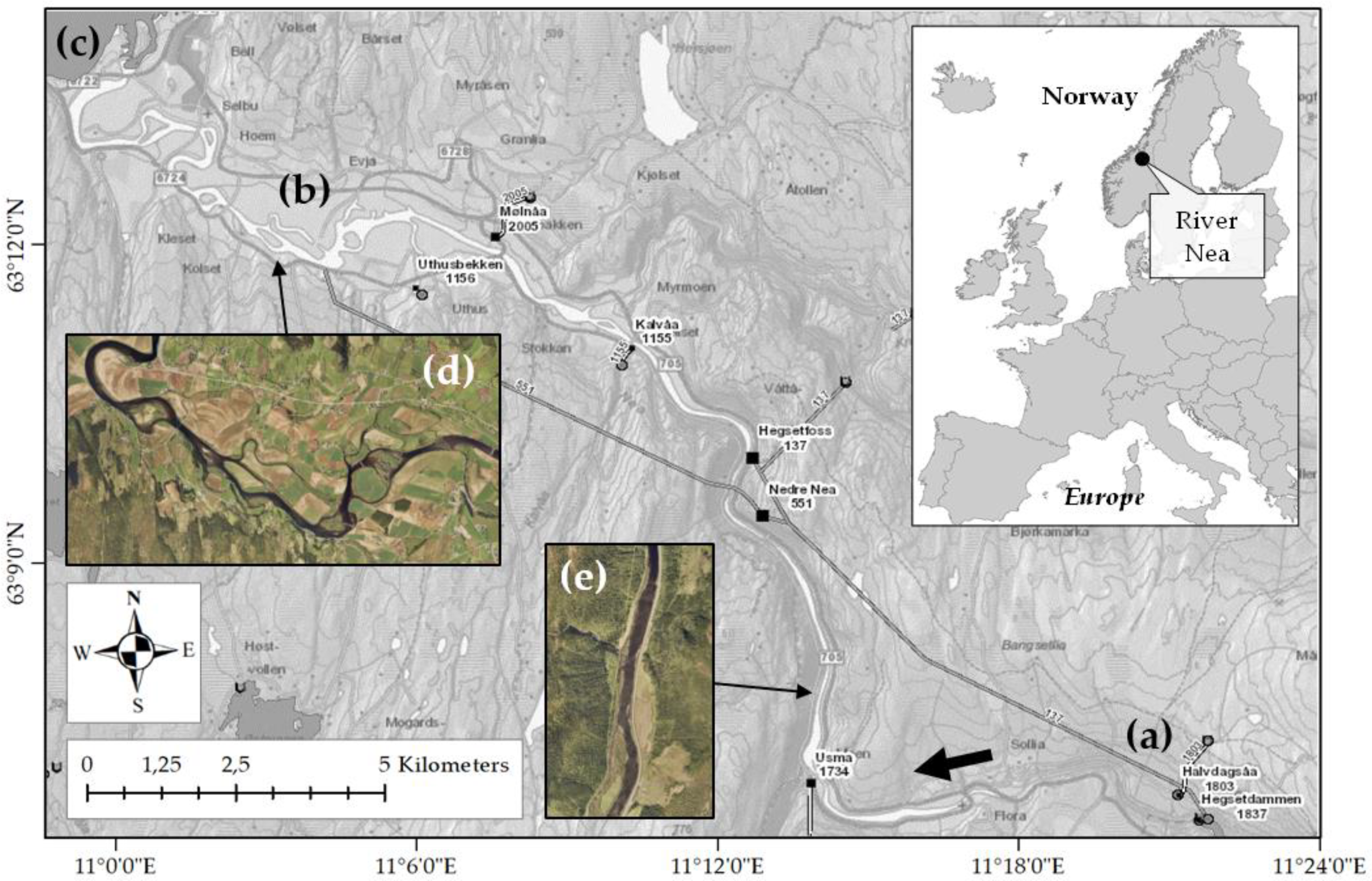

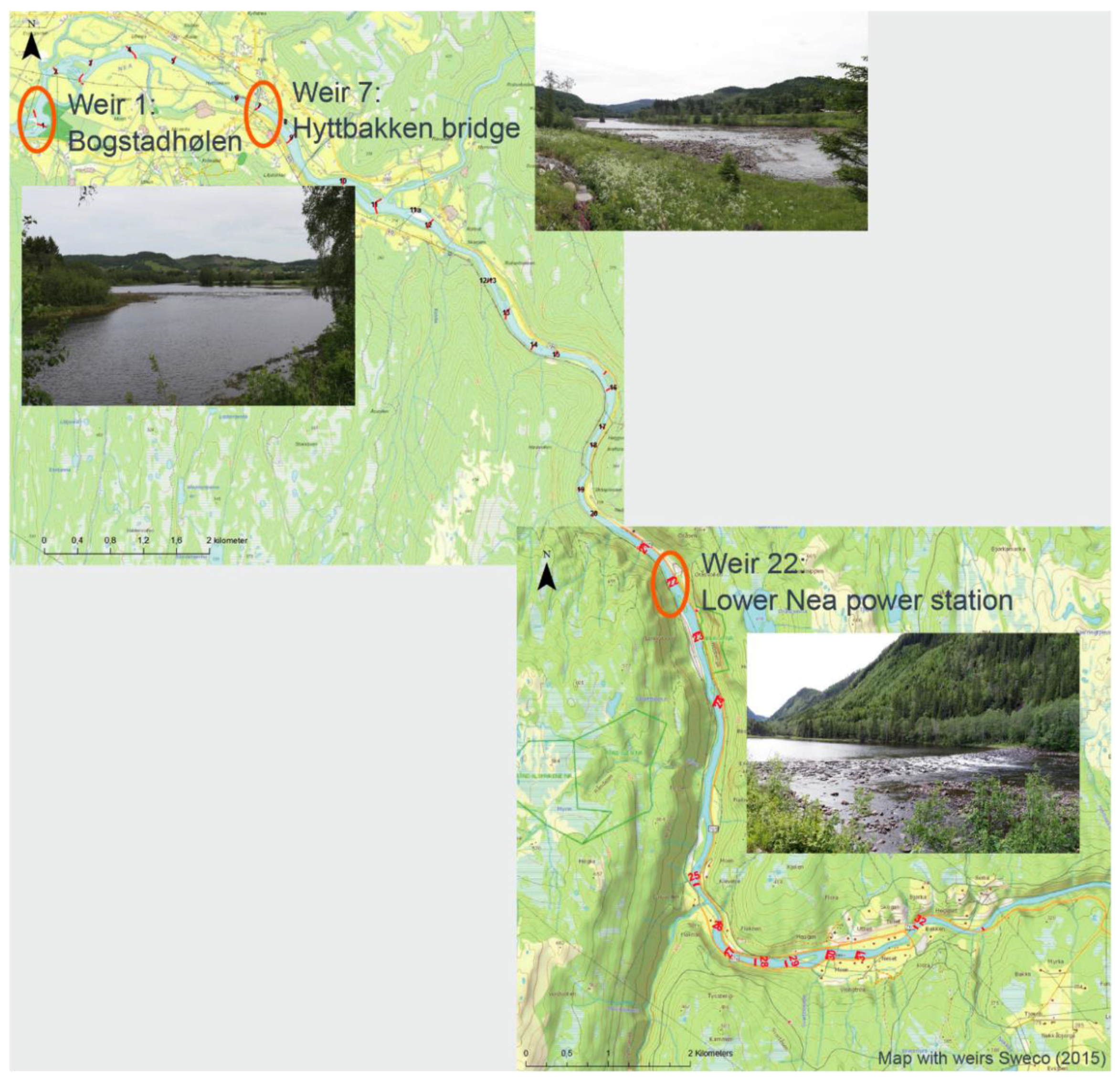
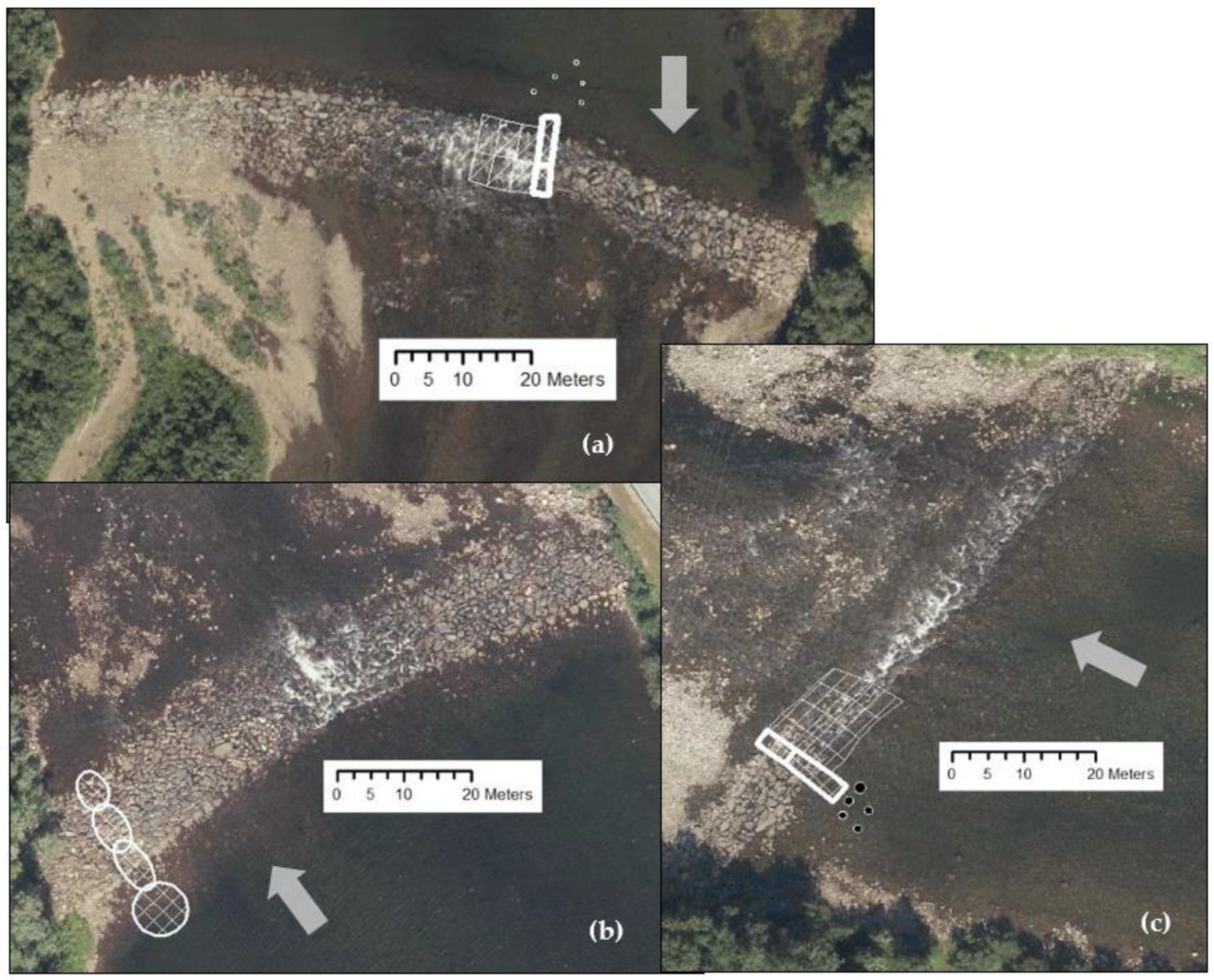
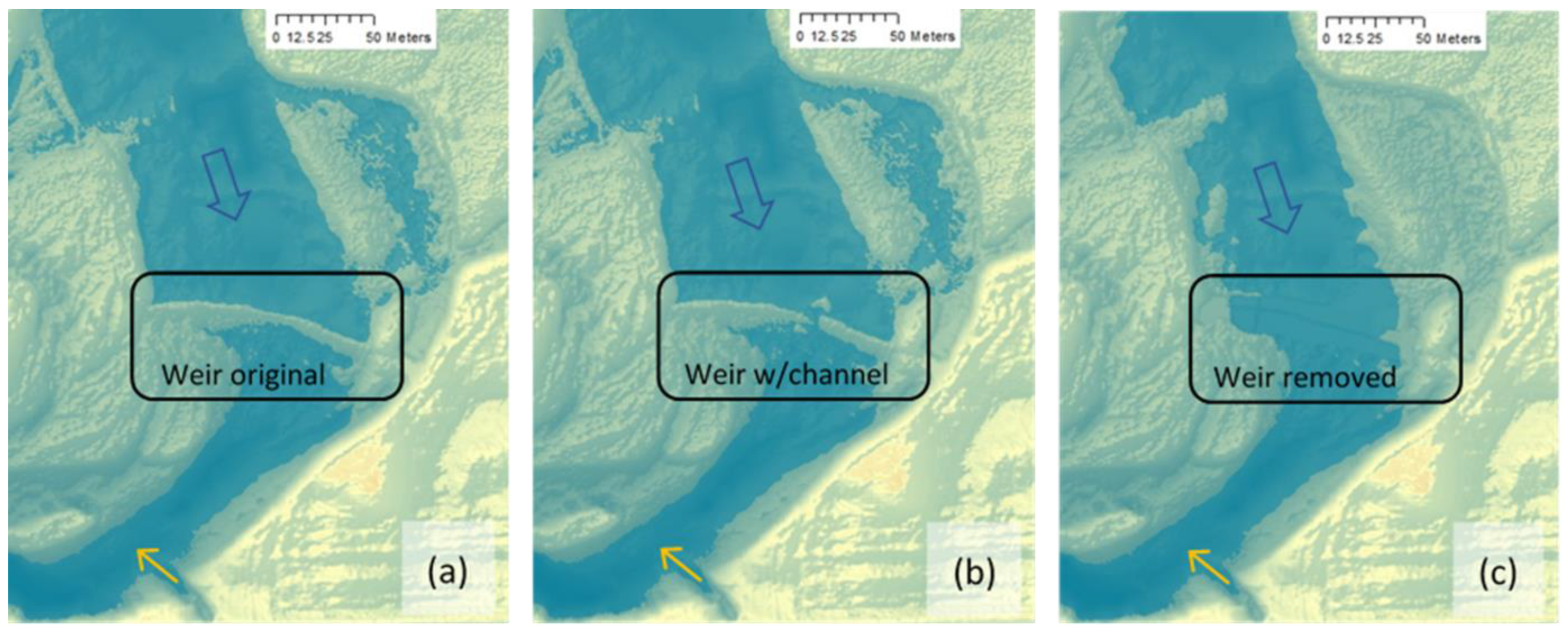
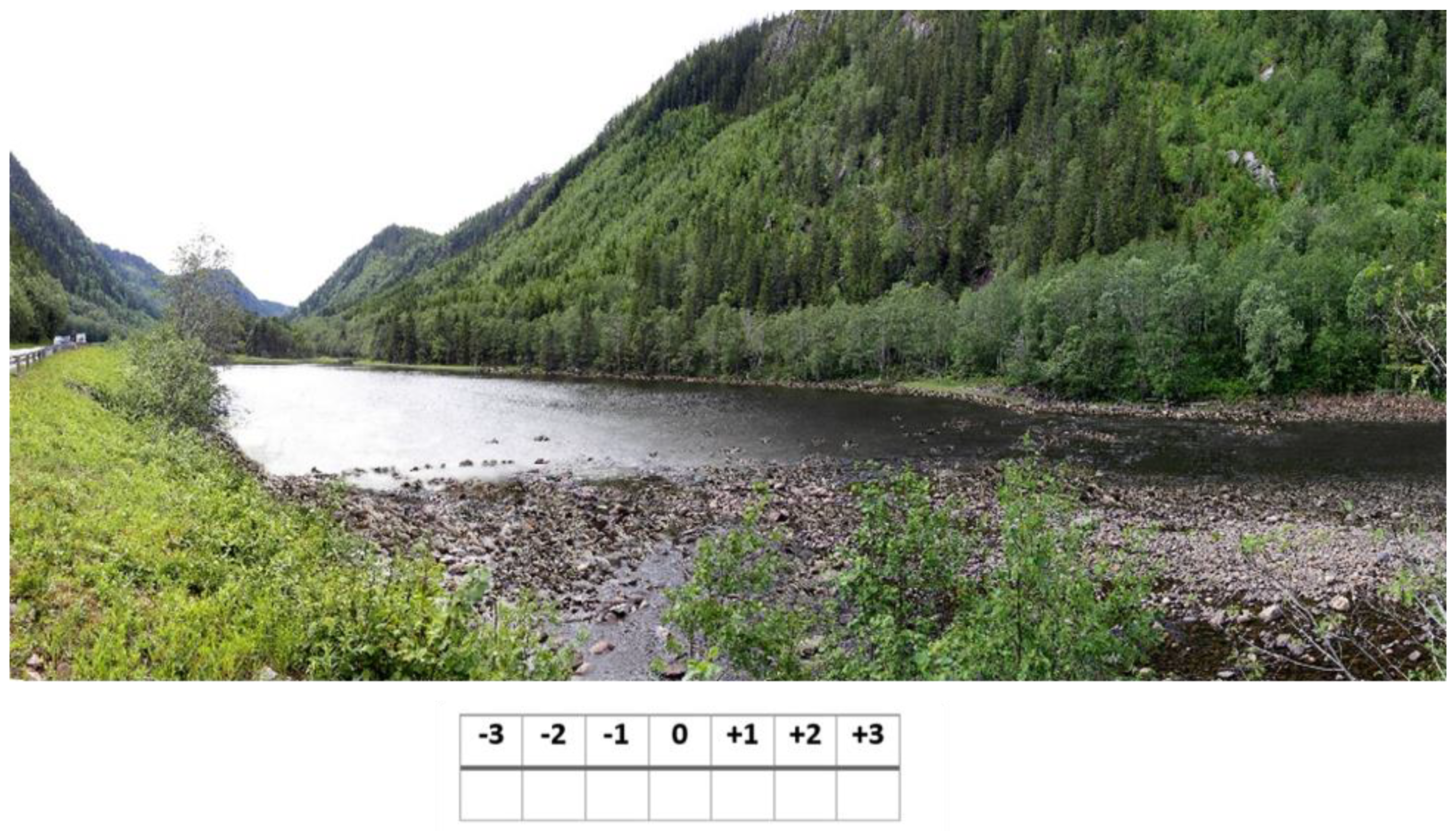
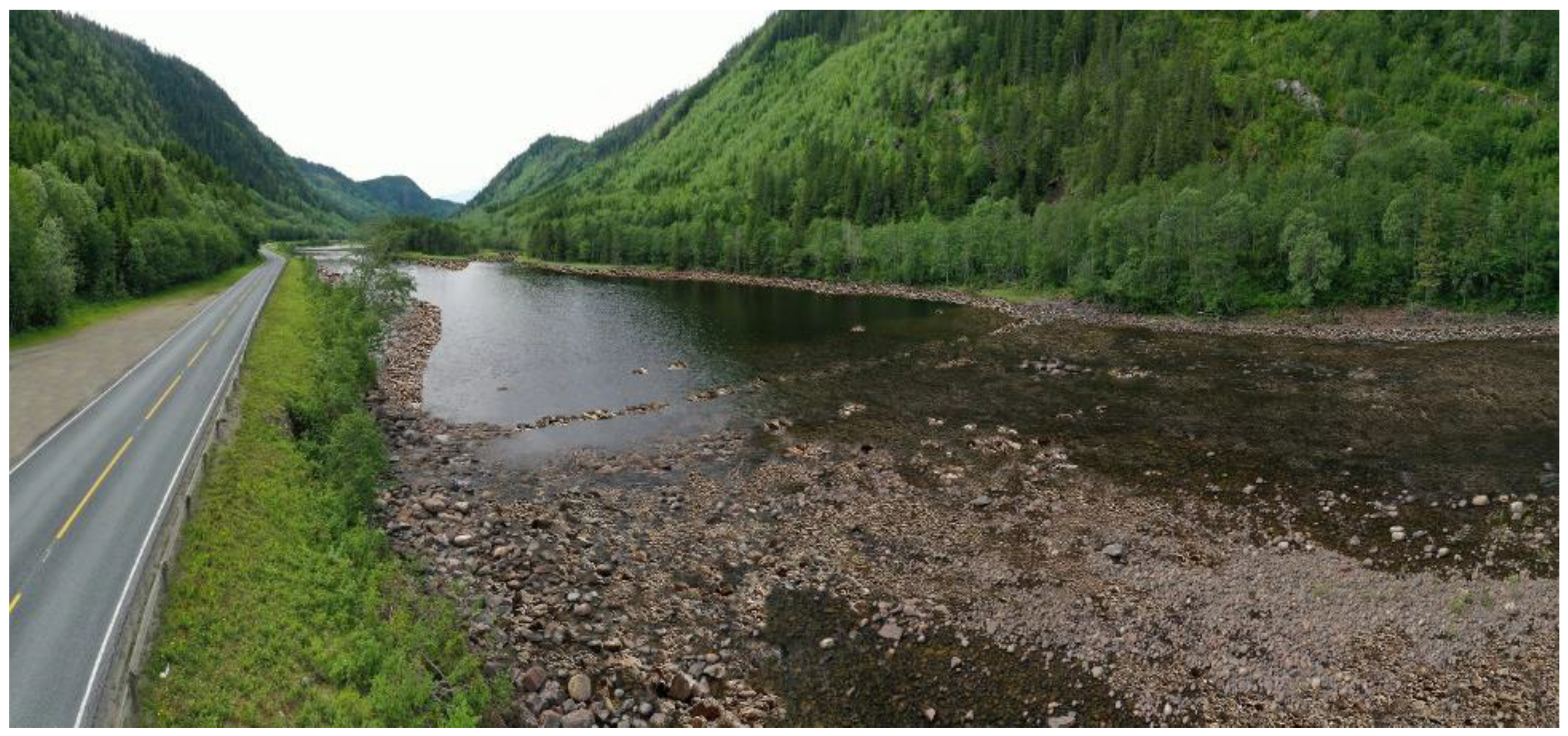
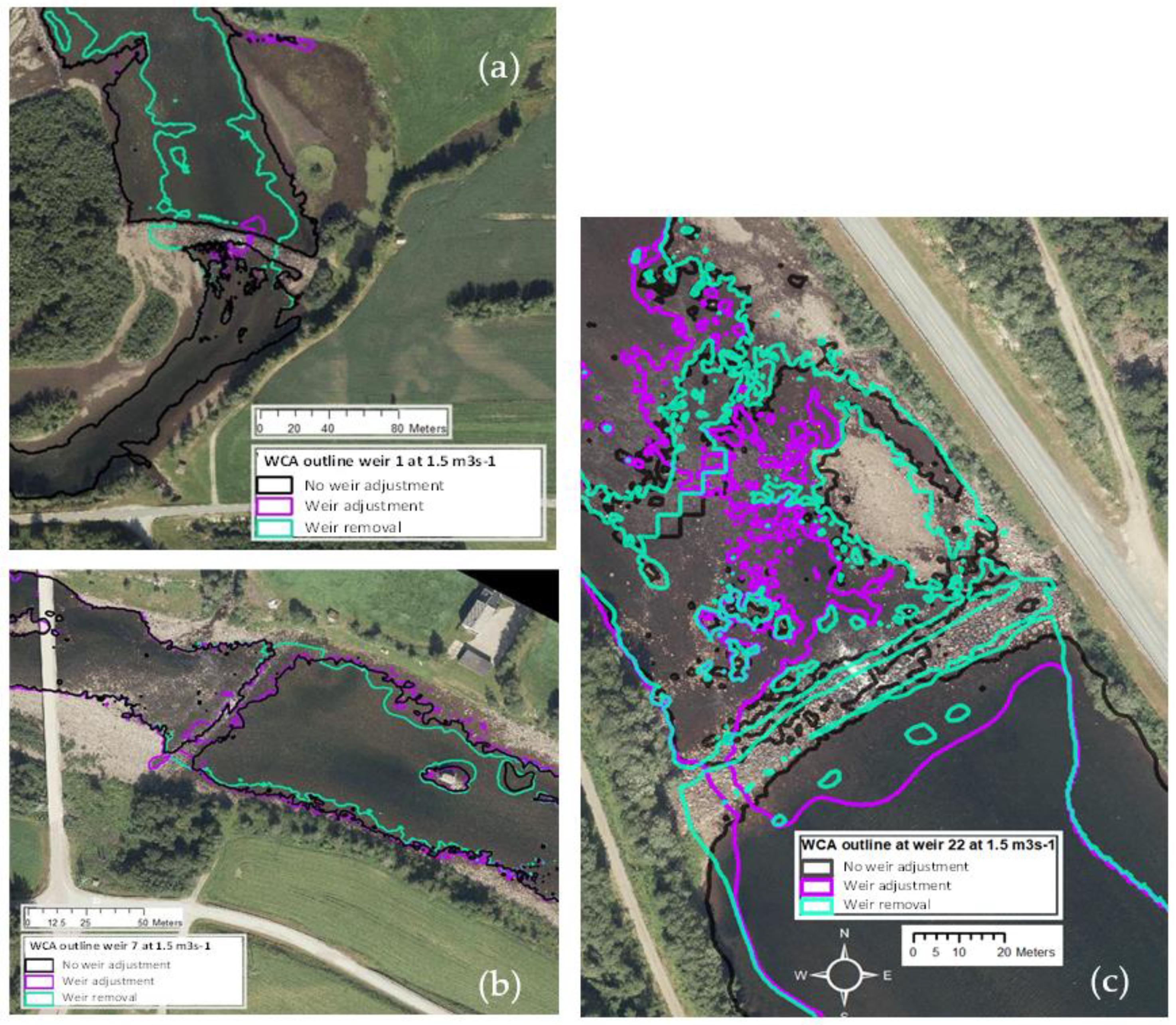
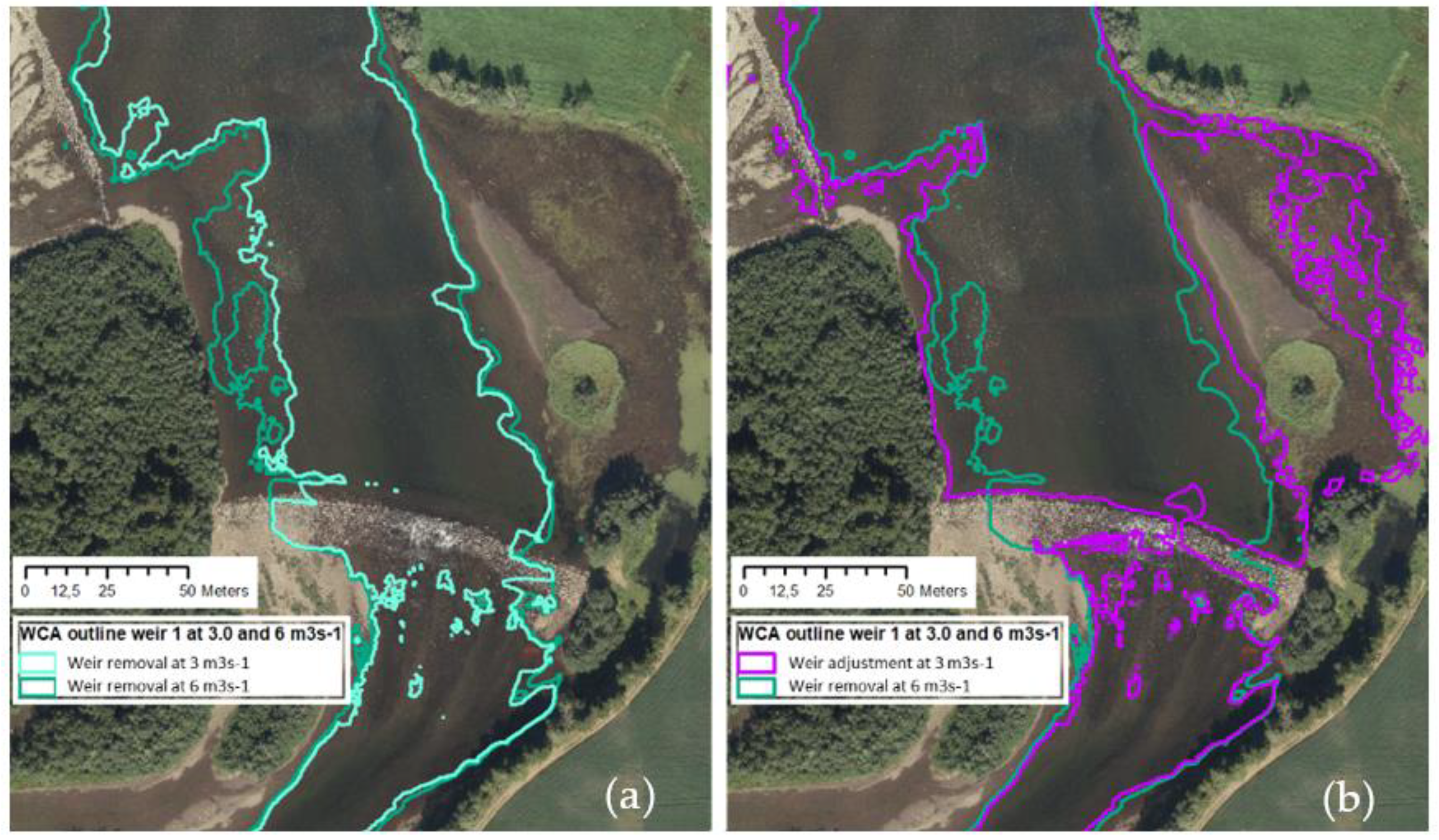

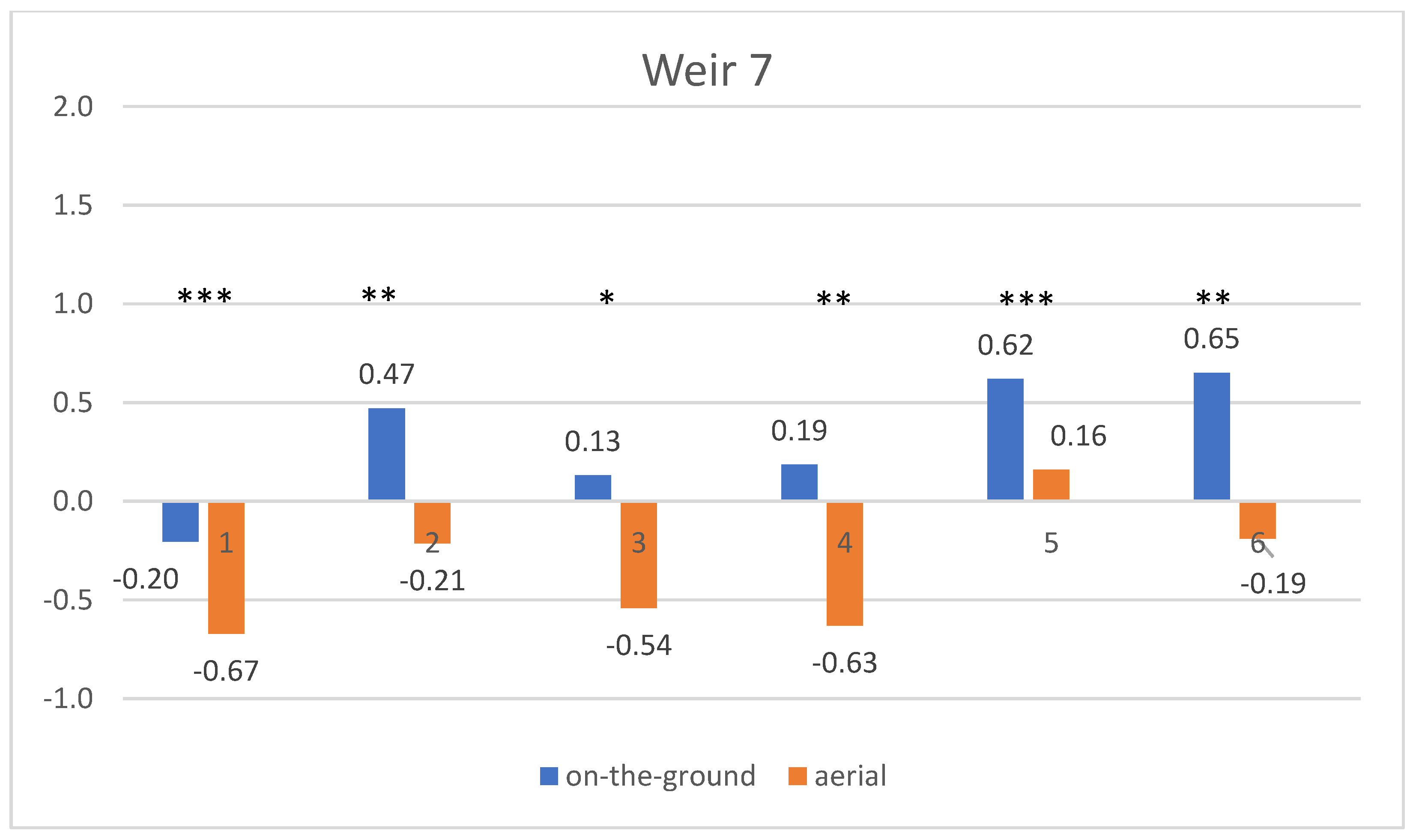
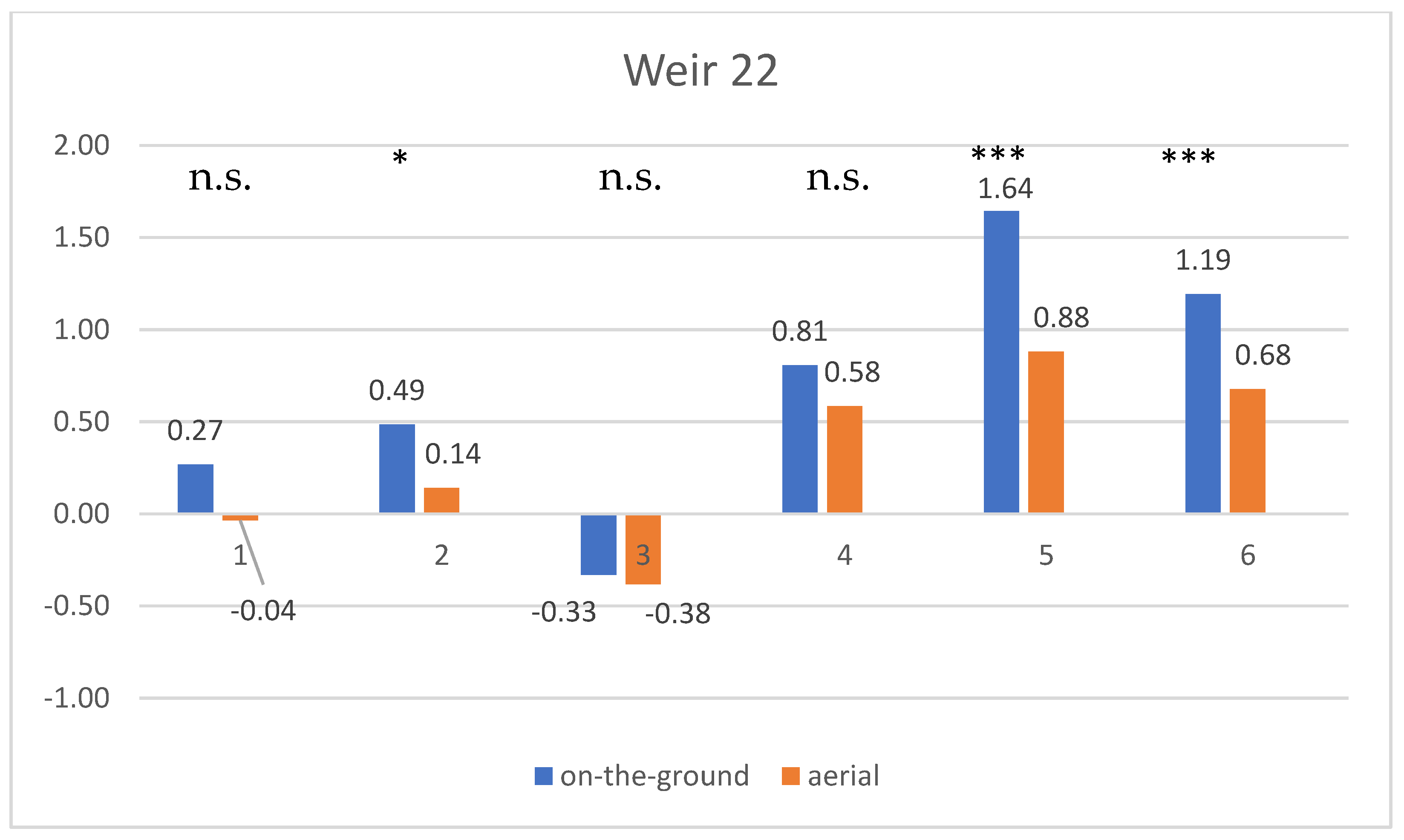
| No. | Weir Configuration | Simulated Weir Adjustment | Simulated Flow in Weirs no. 1/7/22 (m3/s) | Recreational Infrastructure Added to Image |
|---|---|---|---|---|
| 1 | Original form | None | 3.0/1.5/1.5 | None |
| 2 | Original form | None | 3.0/1.5/1.5 | Walking path, information plate, boards and benches, and campfire |
| 3 | Adjusted | Weirs 1 and 7: lowering of midsection and deep channel Weir 22: cell-shaped, partly overlapping pools across weir | 3.0/1.5/1.5 | None |
| 4 | Removed | Removal | 3.0/1.5/1.5 | None |
| 5 | Removed | Removal | 6.0/3.0/3.0 | None |
| 6 | Removed | Removal | 3.0/1.5/1.5 | Walking path, information plate, boards and benches, and campfire |
| Socio-Cultural Variables | Classification | Sample Proportion (%) |
|---|---|---|
| Gender | Female Male | 26.4 73.6 |
| Age | 16–39 40–59 60+ | 9.9 38.0 52.1 |
| Grown up in the case study municipalities | Yes No Partially | 60.3 30.4 9.3 |
| Domicile overlooking Nea River | Yes No | 35.6 64.4 |
| Importance of the Nea River | Low importance Middle importance High importance | 4.7 25.4 69.9 |
| Recreational activity (during the last 12 months) | Fishing Bathing Canoeing Walking along the river Staying at the river (relaxing, picnic, campfire, etc.) Biking along the river Observing animals and plants Ice skating Other | 31.7 31.0 13.9 65.0 49.8 38.0 44.1 3.4 5.2 |
| Mitigation Measures | Existing Weir, Low Flow | Existing Weir, Low Flow Recreational Infrastructure | Weir Adjusted Low Flow | Weir Removed Low Flow | Weir Removed Doubled Low Flow | Weir Removed Low Flow Recreational Infrastructure | |
|---|---|---|---|---|---|---|---|
| Location Perspective | |||||||
| Weir 1 On-the-ground Aerial |  | 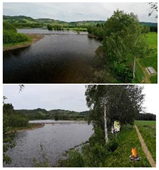 | 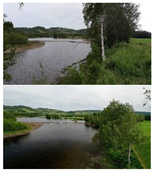 | 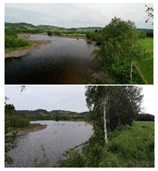 | 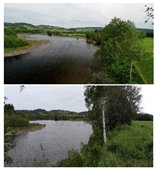 | 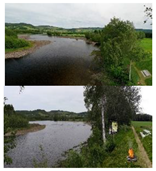 | |
| Weir 7 On-the-ground Aerial |  | 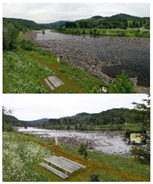 | 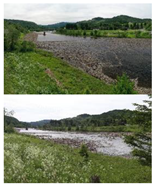 | 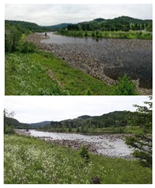 | 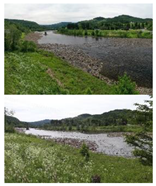 | 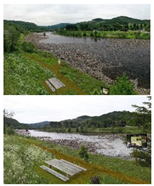 | |
| Weir 22 On-the-ground Aerial | 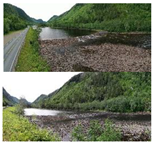 | 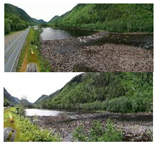 |  |  | 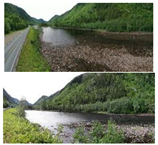 | 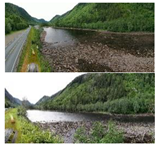 | |
| Weir No. | Perspective | Descending Order of Preference Ratings for Single Scenarios (Scenario No.) |
|---|---|---|
| 1 | On-the-ground | 5–4/6–2–1–3 |
| Aerial | 3–5–4–6–2–1 | |
| 7 | On-the-ground | 6–5–2–4–3–1 |
| Aerial | 5–6–2–3–4–1 | |
| 22 | On-the-ground | 5–6–4–2–1–3 |
| Aerial | 5–6–4–2–1–3 |
Publisher’s Note: MDPI stays neutral with regard to jurisdictional claims in published maps and institutional affiliations. |
© 2021 by the authors. Licensee MDPI, Basel, Switzerland. This article is an open access article distributed under the terms and conditions of the Creative Commons Attribution (CC BY) license (https://creativecommons.org/licenses/by/4.0/).
Share and Cite
Junker-Köhler, B.; Sundt, H. Assessing Visual Preferences of the Local Public for Environmental Mitigation Measures of Hydropower Impacts—Does Point-of-View Location Make a Difference? Water 2021, 13, 2985. https://doi.org/10.3390/w13212985
Junker-Köhler B, Sundt H. Assessing Visual Preferences of the Local Public for Environmental Mitigation Measures of Hydropower Impacts—Does Point-of-View Location Make a Difference? Water. 2021; 13(21):2985. https://doi.org/10.3390/w13212985
Chicago/Turabian StyleJunker-Köhler, Berit, and Håkon Sundt. 2021. "Assessing Visual Preferences of the Local Public for Environmental Mitigation Measures of Hydropower Impacts—Does Point-of-View Location Make a Difference?" Water 13, no. 21: 2985. https://doi.org/10.3390/w13212985
APA StyleJunker-Köhler, B., & Sundt, H. (2021). Assessing Visual Preferences of the Local Public for Environmental Mitigation Measures of Hydropower Impacts—Does Point-of-View Location Make a Difference? Water, 13(21), 2985. https://doi.org/10.3390/w13212985





